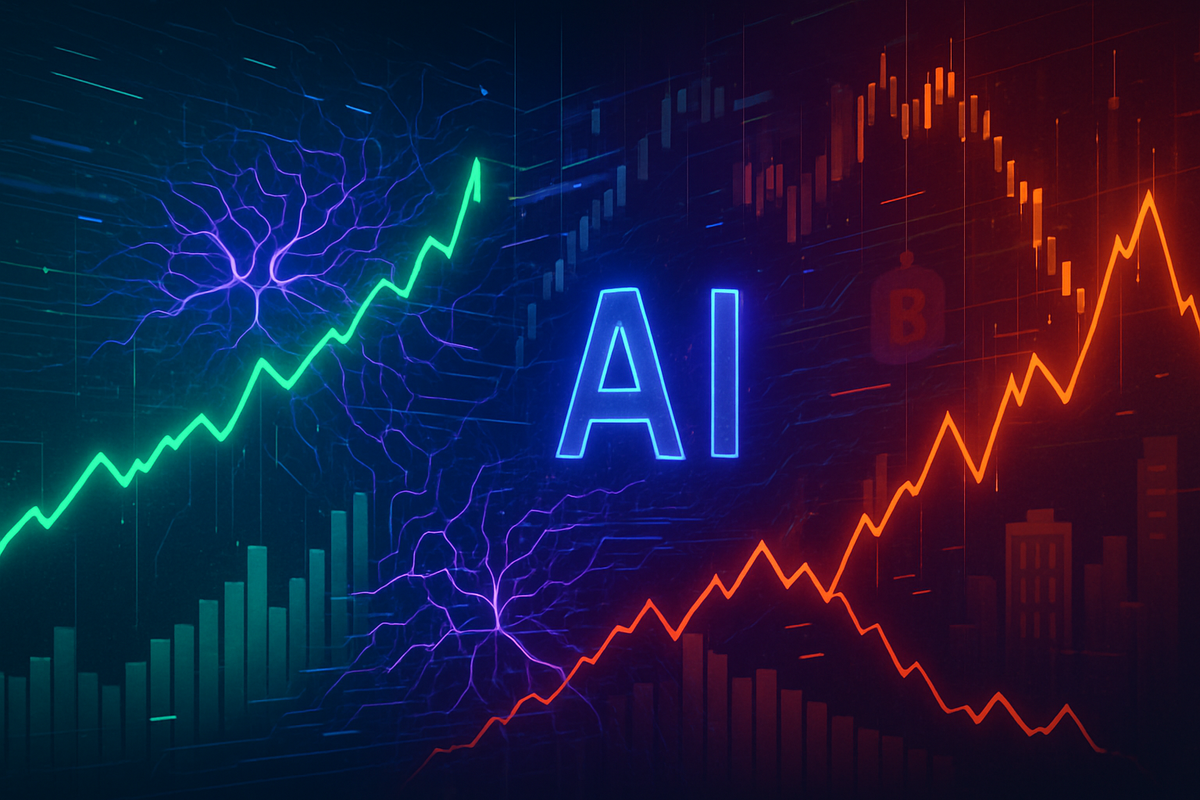Financial News
AI's Unstoppable Ascent: Reshaping Stock Valuations and Forging New Market Leaders

As of October 2025, Artificial Intelligence (AI) stands as the singular, dominant force in global financial markets, consistently overshadowing traditional economic concerns and driving unprecedented shifts in stock valuations. This technological paradigm shift has propelled major U.S. stock indices to record-breaking highs, fueled by fervent investor optimism and colossal investments pouring into the burgeoning AI ecosystem. The market, however, is far from uniformly bullish, exhibiting a highly selective nature where some companies soar to new valuation pinnacles while others grapple with obsolescence.
This extraordinary AI-driven growth has fundamentally redefined sector performance and market concentration. While major indices like the S&P 500 and Nasdaq Composite repeatedly scale new all-time highs, an underlying anxiety about market disparities and the sustainability of these valuations is palpable. This complexity, reflected in an elevated VIX index averaging 27.5 throughout 2025, underscores a highly bifurcated market where discerning genuine innovation from speculative fervor is paramount for investors and companies alike.
The AI Revolution: A Timeline of Market Transformation
The profound influence of AI on stock valuations is not a sudden phenomenon but the culmination of a rapid technological evolution and aggressive market adoption. The journey to October 2025 has been marked by several pivotal milestones and investment trends that have redefined the financial landscape.
The genesis of this market euphoria can be traced back to November 2022, with the public launch of OpenAI's ChatGPT. This event transformed AI from a niche concept into a tangible, broadly applicable force, garnering over 1 million users in just five days and accumulating over 100 million monthly users by early 2023. ChatGPT's viral success served as a major catalyst, attracting immense investor interest in generative AI and igniting a powerful stock market rally.
2023 witnessed the emergence of early AI leaders, as the market recovered strongly, with AI-related stocks consistently reaching new highs. Nvidia (NASDAQ: NVDA), a critical enabler of AI innovation through its advanced chip manufacturing, saw its market capitalization surpass $1 trillion by mid-2023, signaling the hardware backbone of the AI boom. By 2024, private AI investment surged globally, reaching $252.3 billion, a 44.5% increase from the previous year, with generative AI attracting $33.9 billion. Business usage of AI also accelerated, with 78% of organizations reporting AI use. Nvidia's full-year revenue jumped 114% to $130.5 billion, driven by surging data center demand, while the AI-INDEX, tracking high-growth AI companies, rose 60.8%.
The first half of 2025 saw an extraordinary surge, with AI-driven growth contributing an estimated $152 billion to the U.S. GDP. Global AI funding reached an astounding $73.1 billion in Q1 2025, marking the largest quarterly investment in the sector's history. March 2025 was particularly active, with CoreWeave (NASDAQ: CRWV), an AI hyperscaler, conducting a successful IPO, its stock rising over 240% within six months. OpenAI's valuation reached $300 billion. By July 2025, Nvidia's stock hit new all-time highs, surpassing a staggering $4 trillion market capitalization, briefly making it the world's most valuable company. The "Magnificent Seven" (Apple, Microsoft, Nvidia, Amazon, Alphabet, Meta, and Tesla) continued to dominate, but a new class of large-cap companies like Broadcom Inc. (NASDAQ: AVGO), Oracle Corp. (NYSE: ORCL), and Palantir Technologies (NYSE: PLTR) began to emerge as significant contributors to the S&P 500's rally.
As of October 2025, financial markets are experiencing an exhilarating surge, primarily attributed to strong corporate earnings, anticipated Federal Reserve interest rate adjustments, and "insatiable enthusiasm" for AI. OpenAI officially achieved a staggering $500 billion valuation, solidifying its position as potentially the world's most valuable private startup. This was underscored by Oracle (NYSE: ORCL) signing a monumental $300 billion cloud-computing deal with OpenAI, highlighting the immense infrastructure demands of AI. Initial market reactions have been characterized by euphoria, soaring valuations, intense competition, and a flood of investment, though concerns about an "AI bubble" frequently draw parallels to the dot-com era.
AI's Economic Divide: The Winners and The Wary
The AI revolution has sharply delineated the financial landscape, creating a clear class of "winners" whose valuations have soared, and "potential losers" whose business models are either threatened or failing to adapt. As of October 2025, companies providing the foundational layers of AI or successfully integrating it into their core operations are thriving, while others face significant investor apprehension.
Among the undisputed winners are the semiconductor manufacturers and cloud infrastructure providers. Nvidia (NASDAQ: NVDA) remains the quintessential AI success story, dominating the market for GPUs crucial for AI model training and deployment. Its data center business now accounts for the majority of its revenue, propelling its market capitalization to over $4 trillion by July 2025. Similarly, Microsoft (NASDAQ: MSFT) and Alphabet (NASDAQ: GOOGL), through their respective cloud platforms Azure and Google Cloud, are essential enablers, providing the foundational computing power for AI development. Microsoft's deep integration of OpenAI features across its platforms further solidifies its position. Amazon (NASDAQ: AMZN), via Amazon Web Services (AWS), also stands as a major cloud provider, heavily investing in AI/ML services and custom AI chips. Other significant hardware beneficiaries include Broadcom Inc. (NASDAQ: AVGO), projecting $12 billion in AI product revenue by year-end 2025, and Taiwan Semiconductor Manufacturing Company (NYSE: TSM), critical to the global AI supply chain.
The AI hyperscalers and specialized cloud providers are also seeing meteoric rises. CoreWeave (NASDAQ: CRWV), with its IPO in March 2025, has emerged as a formidable player, securing massive compute deals with AI giants like OpenAI and Meta Platforms, totaling nearly $37 billion in bookings. Oracle (NYSE: ORCL) has become a major beneficiary through its Oracle Cloud Infrastructure (OCI), with its cloud business seeing soaring revenue, positioning it as a key partner for innovative AI companies. Oracle's stock jumped 88% in 2025 through September, nearing a $1 trillion market cap due to robust growth and a monumental $300 billion cloud deal with OpenAI. Palantir Technologies (NYSE: PLTR), specializing in data analytics and AI software, has seen its shares climb approximately 2,300% since ChatGPT's release, as its Artificial Intelligence Platform (AIP) drives significant revenue by enabling organizations to build and manage AI applications on their data. AppLovin (NASDAQ: APP), a mobile advertising and analytics firm leveraging AI, has also seen its stock jump over 120% in 2025.
Conversely, a number of sectors and companies are emerging as potential losers, primarily those whose business models are susceptible to automation by AI or are slow to adapt. Companies in creative services and software are facing significant disruption. Firms like Wix.com (NASDAQ: WIX) and Shutterstock (NYSE: SSTK) have seen their stock prices plummet by at least 33% in 2025, while Adobe (NASDAQ: ADBE) shares dropped 23%, amid fears that AI-generated content could replace their traditional services. AI tools can now automate content creation (images, videos, web design) quickly and at a lower cost, reducing demand for human-driven services.
The staffing and consulting industries are also vulnerable. ManpowerGroup (NYSE: MAN) shares have fallen 30%, and Robert Half (NYSE: RHI) experienced a drop of over 50%. Gartner Inc. (NYSE: IT) saw its shares plummet by 30% in just five days after revising revenue forecasts, partly due to concerns that AI could provide cheaper alternatives to its research and analysis services. Traditional advertising agencies like Omnicom (NYSE: OMC) and WPP (NYSE: WPP) have also seen stock declines as investors worry about AI's potential to automate ad creation and media buying. Even some traditional software companies like Salesforce Inc. (NYSE: CRM) and Workday (NASDAQ: WDAY) have experienced selloffs, with declines of 29% and nearly 10% respectively, due to fears that AI could enable applications to be made more quickly and at a much lower cost, intensifying competition. The market is increasingly punishing companies that fail to demonstrate clear AI integration or whose core offerings are directly threatened by AI's capabilities.
The Broader Canvas: AI's Systemic Significance and Echoes of History
AI's pervasive influence on stock valuations extends far beyond individual company performance, signaling a systemic transformation across industries and financial markets. This phenomenon is reshaping broader industry trends, creating significant ripple effects, necessitating new regulatory frameworks, and prompting comparisons to historical market events.
In October 2025, AI is fundamentally altering operations, value chains, and competitive landscapes across diverse sectors. The global investment in AI reached an estimated $280 billion in 2025, with projections for a staggering $50 trillion AI economy by 2030. Industries such as healthcare, finance, manufacturing, and logistics are undergoing fundamental shifts, promising greater efficiency, personalized experiences, and entirely new revenue streams. Companies demonstrating tangible progress in integrating AI are attracting substantial investor interest, with generative AI alone expected to contribute $2.6 trillion to $4.4 trillion in annual global productivity gains. While the "Magnificent Seven" continue to hold significant market capitalization, their growth momentum has diversified, with companies like Broadcom, Oracle, and Palantir emerging as new AI leaders.
The ripple effects are profound, intensifying competition and consolidation. Early adopters and innovators are attracting top talent and capital, while laggards risk losing market share and relevance. This creates a sector-agnostic race for AI adoption, compelling even non-tech companies to invest heavily. In supply chain management, AI is already enhancing efficiency and reducing costs by up to 20%, setting new benchmarks for operational excellence. Strategic partnerships, such as those between Microsoft (NASDAQ: MSFT) and OpenAI, or Unilever (NYSE: UL) and Nvidia (NASDAQ: NVDA), are enabling cost reductions, faster R&D, and market expansion. However, an increasingly "circular" AI ecosystem, where companies invest in their own customers, could be vulnerable to shifts in the business environment.
The rapid advancement of AI has also brought significant regulatory and policy implications. AI governance is becoming essential for ensuring compliance, managing risks, and promoting ethical AI use. Over 40 countries have initiated or enacted national AI policies as of mid-2025, with the EU's AI Act, for instance, requiring full compliance by 2026. This regulatory divergence is impacting strategic decision-making for international financial institutions. Furthermore, the "Global Chip War" sees governments pouring massive investments into domestic semiconductor production, leading to intensifying trade barriers and tech decoupling, which directly affects AI investment flows.
The current AI boom has drawn significant comparisons to the dot-com bubble of the late 1990s. Both periods are characterized by speculative investments, rapid valuation increases, and considerable hype around transformative technology. Goldman Sachs CEO David Solomon warned in October 2025 of a potential AI-driven stock market drawdown, drawing parallels to the dot-com era's speculative fervor. The surge in valuations for companies like OpenAI, jumping from $300 billion to $500 billion, further fuels these comparisons. However, crucial differences exist: today's leading AI companies, unlike many dot-com startups, are often highly profitable with strong revenue streams and significant cash flow. AI also has visible, tangible adoption across various applications, delivering measurable results rather than just promises. While some AI stocks may be overvalued, a wholesale market collapse like 2000-2002 is considered unlikely, with the long-term impact more comparable to foundational technologies like railroads that, despite early volatility, ultimately transformed the economy.
The Road Ahead: Navigating AI's Future Landscape
As of October 2025, the AI revolution is far from over, presenting a complex interplay of short-term volatility and long-term transformative potential. Navigating this landscape requires strategic foresight from companies and discerning analysis from investors.
In the short-term (October 2025 - October 2026), robust performance is anticipated from companies deeply embedded in the core AI ecosystem, particularly those providing essential hardware, software, and cloud infrastructure. The demand for powerful chips, sophisticated AI models, and scalable data solutions is expected to sustain revenue growth for market leaders like Nvidia (NASDAQ: NVDA), Microsoft (NASDAQ: MSFT), and Alphabet (NASDAQ: GOOGL). A key trend is the acceleration towards "agentic AI"—AI systems capable of autonomous decision-making—expected to transform industries from autonomous vehicles to financial trading. Global AI spending is projected to reach $375 billion in 2025 and grow another 33% in 2026. However, increased market fluctuations are probable due to concentrated growth and "AI bubble" anxieties, with some analysts predicting a correction in Q4 2025. Investors will increasingly focus on whether AI delivers tangible outcomes and long-term value, beyond mere hype.
Long-term (beyond 2026), the AI market is projected to experience exponential growth, with global market size potentially reaching $1.81 trillion by 2030, and some forecasts stretching to $4.8 trillion by 2033. AI is widely considered a transformative technology, comparable to electricity, with the potential to contribute over $15 trillion to the global economy by 2030. This profound impact will extend across virtually every sector, driven by technological breakthroughs like quantum computing integration, advanced natural language processing, and AI-driven drug discovery. The market may become dominated by a few large players, however, leaving many companies behind if they fail to effectively integrate AI.
For companies, strategic pivots are no longer optional but a business necessity. Deep AI integration into core operations, focusing on practical, scalable, and industry-specific solutions, is paramount. Investment should pivot towards building scalable, knowledge-driven systems and monetizing AI through software "agents" rather than just infrastructure build-out. Talent and culture transformation, robust data strategies, and proactive engagement with ethical AI standards are also crucial. A significant challenge is the "AI value gap," where only 5% of companies are achieving AI value at scale, while 60% struggle to translate investments into material benefits.
Market opportunities abound in hardware, infrastructure, software, AI agents, and industry-specific solutions for health tech, data intelligence, and cybersecurity. "Green AI," combining AI with sustainable practices, also presents a long-term opportunity. However, significant challenges include valuation bubble concerns, regulatory and ethical hurdles, infrastructure and energy bottlenecks, intense competition, and talent shortages. Multiple scenarios could unfold, from a sustained growth and productivity super cycle to a market correction and re-evaluation, or a shift in market leadership beyond the initial "Magnificent Seven."
The Enduring Impact: A Market Reimagined
The influence of AI on stock valuations in October 2025 is not merely a transient market phenomenon but a profound reordering of the global economic landscape. It is driving significant wealth creation for companies at the forefront, while simultaneously challenging traditional business models and creating a stark divide between those that adapt and those that falter.
The key takeaways underscore AI's colossal impact on market capitalization, epitomized by Nvidia's (NASDAQ: NVDA) ascent to a $4 trillion valuation. The "Magnificent 7" remain significant, but a new wave of AI winners like Palantir Technologies (NYSE: PLTR) and CoreWeave (NASDAQ: CRWV) are emerging. This surge is largely underpinned by strong corporate fundamentals and tangible demand for AI solutions, distinguishing it from purely speculative bubbles for many analysts. However, concerns about an "AI bubble" persist, with some market leaders, including Goldman Sachs CEO David Solomon, warning of a potential drawdown in the next 12 to 24 months, drawing parallels to the dot-com era. The market is increasingly scrutinizing whether AI investments translate into actual free cash flow and sustainable profitability, especially for hyperscalers.
Moving forward, the market will remain dynamic. While bullish sentiment largely prevails, particularly for companies deeply embedded in the core AI ecosystem, underlying anxieties about market concentration and the sustainability of soaring valuations are growing. The "AI value gap" is a critical concern, highlighting that only a small fraction of companies are successfully translating AI investments into measurable financial benefits. This suggests a future where value creation from AI may become highly concentrated among a few leading "future-built" firms.
The lasting impact of AI is its role as a foundational technology that is not just a trend but a transformative force. It is driving a revolution in value creation, enabling organizations to build new business models and access different value pools at an unprecedented pace. AI is enhancing productivity and efficiency, accelerating innovation, revolutionizing customer experience, and transforming operational capabilities across virtually every industry. Ethical considerations, data privacy, and robust governance frameworks will become increasingly crucial for companies to harness AI's full potential while mitigating associated risks.
Investors should watch for several key indicators in the coming months. Closely monitor Q3 earnings reports, particularly the capital expenditure plans of major hyperscalers (Microsoft (NASDAQ: MSFT), Alphabet (NASDAQ: GOOGL), Amazon (NASDAQ: AMZN), Meta Platforms (NASDAQ: META)), as their spending on AI infrastructure fuels the current rally. Discern between real value generation and mere hype, focusing on companies demonstrating concrete, measurable results from AI deployments. Pay attention to market concentration and any further indicators of a bubble, such as speculative deals for unprofitable generative AI businesses. Regulatory developments globally will also be critical, as new policies could significantly impact AI business models. Finally, observe AI adoption trends in traditional industries and the free cash flow growth of heavily invested AI companies, as these will be crucial for long-term sustainability.
This content is intended for informational purposes only and is not financial advice
More News
View More




Recent Quotes
View More
Quotes delayed at least 20 minutes.
By accessing this page, you agree to the Privacy Policy and Terms Of Service.



